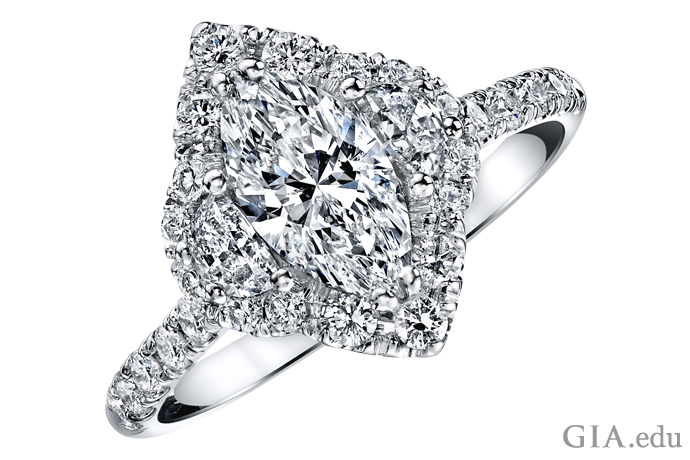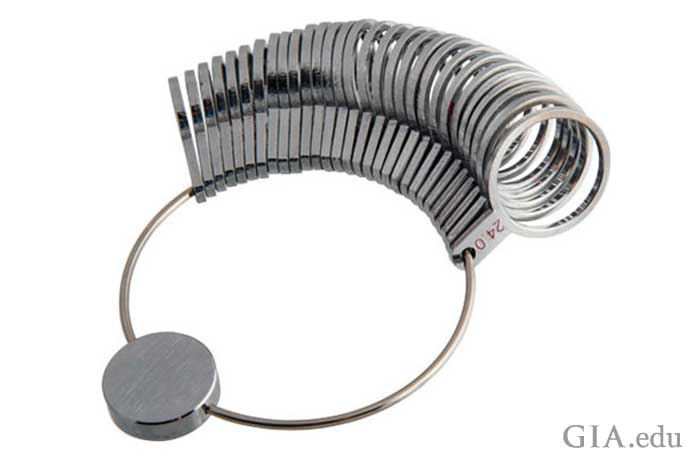Jewelry stores are one of the first places to look when buying an engagement ring. The jeweler will ask some questions as he or she helps you narrow down your choices. Knowing what these questions are can help you go in prepared.
What questions will a jeweler ask?
1. How long have you been shopping for an engagement ring?
2. When do you plan to propose?
3. What is your engagement ring budget?
4. Are you familiar with the 4Cs of diamond quality?
5. Are you looking for a round brilliant or a fancy shape diamond?
6. What ring style are you looking for?
7. What color metal are you looking for?
8. What ring size do you need?
1. How long have you been shopping for an engagement ring?
More than just a question to break the ice, a jeweler will ask this to gauge where you are in the diamond buying process and how much knowledge you might already have. If you’ve just started shopping, any good jeweler will happily describe the steps to selecting an engagement ring and begin educating you about diamond quality, jewelry settings, and more.

This ring incorporates two very popular setting styles—the three-stone and the halo. Colorful side stones can give your diamond ring a pop of color. They can also represent someone’s birthstone. Courtesy: Ziva.
2. When do you plan to propose?
Before you buy a diamond engagement ring, the jeweler will want to make sure there is sufficient time to create your perfect diamond ring. Engagement rings with premade settings ready to be set with a diamond center stone of your choice are called semi mounts). They can take anywhere from a few days to a week to make. A custom ring can take several weeks to make, so be sure to plan your proposal accordingly.
3. What is your engagement ring budget?
This question will help you navigate through a wide range of price points. When buying a diamond engagement ring, prices can run anywhere from hundreds to hundreds of thousands and more. That’s why setting a budget is essential, and it’s one of the first topics your jeweler will bring up. A good jeweler will help you find the best quality engagement ring for your money and ask questions to help you get there.

Color and clarity are especially important in emerald cut diamonds, since inclusions are easily noticeable due to the large, long facets. Seen here is a D color, Flawless clarity emerald cut diamond. Courtesy: Christie’s Images Ltd.
4. Are you familiar with the 4Cs of diamond quality?
This is by far one of the most important questions your jeweler will ask, because the price of your engagement ring is largely determined by the quality of the diamond, or diamonds, in the ring. The diamond’s color (or how colorless it is), clarity (how free from inclusions it is), cut (its proportions and symmetry), and carat (its weight, which influences size) determine the diamond’s overall rarity and ultimately its price. The 4Cs provide essential quality factors that describe a diamond. The higher the quality of a diamond, the rarer it is, and the more expensive it will be.
Each “C” is assessed differently and contributes to a diamond’s overall quality in a different way. A well-trained jeweler will not only explain the 4Cs to you, but they will also help you understand the differences between stones. Two stones that look alike can have very different price points, and two stones with similar 4Cs can look different, so it is important to pay attention.
Your jeweler may ask which of the 4Cs is most important to you and show you options that match. For instance, if a certain size is essential, you should know how carat weight affects the cost of a diamond. Large diamonds are more expensive per carat than smaller diamonds of the same quality.
A GIA Diamond Grading Report is invaluable during this process since it provides an objective evaluation of a diamond’s quality, including a full 4Cs assessment and more. GIA (Gemological Institute of America) is an independent, nonprofit organization that does not buy or sell diamonds, and invented the 4Cs and the grading system to evaluate diamond quality used all over the world. You can trust that information on a GIA diamond grading report is objective and accurate, so ask your jeweler to only see diamonds that come with a GIA report.

Large, colorless, flawless diamonds are exceptionally rare. A diamond like this D color, Internally Flawless, 2.78 ct stone is certain to have a higher price point. Photo: Robert Weldon/GIA. Courtesy: Rogel & Co., Inc.
5. Are you looking for a round brilliant or a fancy shape diamond?
The round brilliant cut diamond has been the most popular cut for decades. It is estimated that round diamonds make up 75% of all diamonds sold and 53% of all diamond engagement ring center stones. When it is well cut, it has more sparkle and brilliance than any other cut.
Even though the round brilliant is the most popular, other diamond shapes known as fancy shapes each have their own charm. Elongated shapes such as the marquise, the oval, and the pear can have a slimming effect on the wearer’s hand, making the fingers look longer. Step cuts, such as emerald cuts and Asscher cuts have a clean, elegant gleam. Heart shapes can be unique and romantic.

This marquise cut diamond is flanked by two half-moon cut diamonds and surrounded by a halo of round brilliant cuts, giving the ring plenty of sparkle and glamor. Courtesy: Ziva Jewels.

This ring combines the best of modern and vintage, with a princess cut diamond surrounded by milgrain and lattice work. The bezel setting protects the princess cut’s sharp corners. Courtesy: Brilliant Earth.
6. What ring style are you looking for?
Engagement ring styles can be classic (solitaire, halo, three stone), minimalist (tension set), vintage, glamorous and dramatic, delicate, bohemian, and more. Know what look you’re going for and what shapes or settings might best suit the wearer’s lifestyle.
Prong settings show off more of the diamond, but this setting leaves the stone more vulnerable to damage. For someone who is a medical personnel (and often has to wear gloves) or enjoys a more active, outdoors lifestyle, bezel settings are a smooth, snag-free, safer choice. It wraps around the sides of the diamond to protect the diamond from accidental bangs and bumps. While diamonds are incredibly hard, they can still chip upon hard impact. The points on marquise cuts, pear cuts, heart cuts, and princess cuts, need to be protected by prongs or their setting. Halos can be a practical and glamorous way to protect diamonds as well.
7. What color metal are you looking for?
When buying a diamond engagement ring, you’ll have the option of selecting the metal, which is typically yellow, white or rose gold, platinum or a combination of metals. Yellow gold has been used in jewelry for thousands of years and was popular in antique and vintage jewelry, including Victorian era and Retro era diamond engagement rings. Rose gold was also popular during the Victorian and Retro eras and is still widespread today. White metal was fashionable during the Edwardian and Art Deco eras and is still going strong. Platinum or white gold are your two main white metal choices.
Keep in mind that diamonds will reflect the color of the metal you are setting them in. If you buy a diamond with a high color grade (D, E, or F), it is better to set the diamond in a white metal setting, or the warmth of the yellow or rose gold metal will be reflected in the diamond and make it appear deeper in color than it is. Diamonds with lower color grades (K and below) should typically be set in warmer metals such as yellow or rose gold, or the stone may look warmer in contrast with the white color of the metal.

Rose gold jewelry is known for having a modern and romantic look. Courtesy: evelynH Jewelry, Inc.

This diamond ring contains both white and rose gold. Rose gold boosts the color of the pink diamond melee, while white gold matches the icy beauty of the diamond. Courtesy: Rahaminov Diamonds.
8. What ring size do you need?
Rings can generally be resized two sizes up or down from their original size. But having melee on the band can make this process more costly and complicated. To save time and money, it is best to know the wearer’s ring size before purchasing the ring.
If you’re shopping for the ring together, you can use your jeweler’s finger gauges to determine the exact ring size. If you want to find out your loved one’s ring size while keeping the ring a surprise, you can:
• Press a ring they wear on their ring finger into a bar of soap until it creates an impression. Bring this to the jeweler.
• Use a pencil to trace the inside of one of their rings on a piece of paper. Bring this to the jeweler.
Our blog on How to Determine Ring Size is filled with other helpful tips – and pitfalls to avoid. Read it to ensure the ring will fit just right.

Photo: Eric Welch/GIA.
What to expect after buying a diamond engagement ring
A jeweler is likely to explain what kind of services they provide after buying a diamond engagement ring. Typically, they will recommend having the ring cleaned frequently and having the prongs checked at least once or twice a year to make sure they are holding the diamond firmly in place. Take advantage of these services, if they’re offered, because a loose or damaged prong can cause a diamond to fall out of its mounting.
After purchasing a diamond engagement ring, you should consider having it appraised and insured. An appraisal is an estimate of a diamond’s monetary worth based on current market conditions and the quality of the diamond. GIA reports are invaluable in helping appraisers assign value based on the objective assessment of a diamond’s quality. Replacement value can be used for insurance purposes, helping protect your purchase should it ever be lost or stolen. Keep in mind that appraisals should only be done by an independent professional who has no stake in the sale so that you get an accurate, unbiased assessment of your ring’s worth.

This ring combines two popular styles—the bypass ring and the toi et moi ring. Toi et moi means “you and me” in French, features two center stones representing a couple coming together as one. The two stones in this ring are a 4.06 ct, pear shaped, Fancy Brownish Yellow, SI1 diamond and a 3.02 ct pear shaped, colorless diamond.
Ready to propose but not ready to buy an engagement ring? A placeholder engagement ring might be just what you need.
